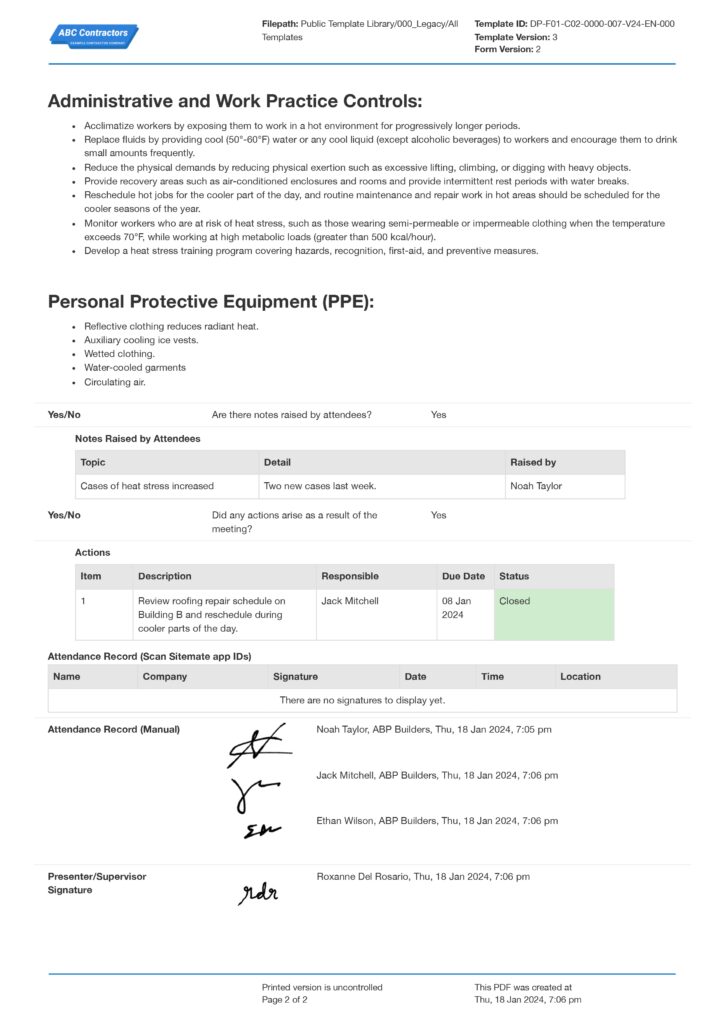Dashpivot Article – Heat Stress Hazards and Control Measures
Heat Stress Hazards and Control Measures
To prevent heat stress at work, one must first learn about the critical risks and control measures you should understand and have in place, which we will discuss in this article here.

Heat Stress Safety
According to the Health and Safety Executive (HSE), heat stress happens when the body's way of controlling its internal temperature starts to fail. There are many factors that contribute to heat stress. The most common contributors are warm environmental settings, air temperature, humidity, clothing, work rate, and nature of work. It is important that companies and establishments recognize heat stress and its hazards so that the right control measures can be taken to avoid its effects.
It is especially vital to industries that are at high risk ratings for heat stress. These include construction, agriculture, manufacturing, mining, and firefighting.
These industries should properly establish a safety program for heat stress by doing a field-level risk assessment to identify heat stress hazards, assess the risk, and provide appropriate measures.
Having this program will ensure that workers are safe from harm when working in high-risk environments for heat stress
Heat Stress Hazards and Control Measures
To help you in your safety program for heat stress, we will be providing example hazards that cause heat stress to help give you a clearer picture of what to look for during your risk assessment, and we will be suggesting control measures that you can use to control these hazards that contribute to heat stress.
Heat Stress Hazard - High Temperature Environments
Temperatures of 30 degrees Celsius (86 degrees Fahrenheit) or above are considered to be high-temperature work conditions. These sorts of locations are prone to heat stress, particularly when there are activities that are physically demanding involved. Due to the fact that perspiration does not evaporate as efficiently in high-temperature surroundings, the body's capacity to regulate temperature is hindered.
Ensuring that there is enough ventilation is the most effective method for mitigating this risk. Machines that provide ventilation, such as fans and blowers, should be able to properly cool the environment and enable perspiration to evaporate naturally.
Humid Environments
The quantity of water vapor that is present in the air is what is referred to as the humidity. Extremely humid settings have the same impact as high-temperature environments, just as high-temperature situations do. It is difficult for perspiration to evaporate properly in an atmosphere that is humid because the water vapor in the air is already concentrated.
This implies that the body's capacity to regulate temperature is hindered since sweat cannot evaporate effectively.
When dealing with situations like these, the most effective method of control is to bring open air into the workplace. Installing ventilation machines is an alternative in the event that open air is not a viable choice.
Poorly Ventilated Environments
Poorly ventilated environments are an igniter for producing hot and humid environments. We have formerly discussed how these two can cause heat stress in the workplace. By using two different control strategies, you may successfully avoid the accumulation of heat and humidity.
Naturally, the first step is to install a ventilation machine in the area. If you have an alternate working arrangement, this is the second control measure that you might supply for the situation. One worker can work in the area for an hour, and then another person can take their place.
By minimizing the amount of time that the worker is exposed to the hot environment, this method may minimize the likelihood that the worker will experience heat stress.
Heat Stress Hazard - Direct Sun Exposure
There are countries that have more exposure to the heat of the sun. Near the equator, most of these countries receive more direct sunlight than any other parts of the earth. Having said this, outdoor activities in these regions have a high risk of heat stress.
A prime example of this is the installation of roofs during construction projects. The activity will expose workers directly to the sun for long hours.
It would be beneficial to implement control measures such as providing temporary shade for workers, encouraging them to wear light clothing, ensuring access to water, and implementing alternate working arrangements.
Heavy Works
If we exert much effort in doing physical activities, the body's natural response is to heat up. This happens because when you do these physical activities, your muscles contract, and when muscles contract, energy is spent. When energy is spent, the byproduct is heat. We refer to this entire process as metabolism. There is no control measure to eliminate this process in our body.
However, as ingenious beings, we have already innovated a number of machines that make our work easier.
When planning for work, you could consider using these machines to lessen the need to exert muscular force and conserve energy for more important matters.
Hot Works
Activities that use machines or equipment that generate heat can be a cause of heat stress, especially when the area is already hot and humid and the heating work requires long hours. Welding is a wonderful example of this. The activity generates up to 3300°C (6000°F) at the point of contact when welding two materials. The radiating heat from this activity can contribute greatly to increasing the temperature of the area.
There are several options to choose from for implementing control measures in hot work activities.
To control the radiation of the heat, companies can deploy heat shields and insulating materials. Additionally, alternating work schedules can help manage these kinds of activities to avoid heat stress.
Heat Stress Common and Very Dangerous Hazard - Poor Hydration
Water is an essential need in our daily lives, especially in regulating temperature. It was even taught to us when we were young that we need to at least drink 8 glasses of water daily to be fully hydrated. In industries where most workers perform physical labor, they need to stay properly hydrated because they lose more water through constant exertion. This step is vitally important since workers might experience dehydration, which could lead to heat stress.
Dehydration happens when your body loses or uses more fluid than it takes in, leaving it without enough water and other fluids to do its regular tasks. Dehydration will result if you don't replenish lost fluids.
To prevent dehydration, personnel must understand why they need to practice drinking more water. Companies can also provide a station where water is readily accessible to workers when working.
Educating workers about Heat Stress Safety, Hazards and Control Measures
Heat stress can be eliminated or mitigated if the proper measures are placed. One of the costless measures that companies can employ is educating the workers about heat stress. With heat stress awareness, employees can discern the hazards that have the potential to induce heat stress and can immediately provide themselves protection from such dangers.
One of the best avenues through which you could teach the workers about heat stress is through toolbox talks. Toolbox talks are informal meetings that target discussing safety topics. This is also a space where workers can raise their safety concerns and have them addressed, further strengthening the safety measures in the workplace.
To conduct a successful toolbox talk, companies must create toolbox talk forms. Toolbox talk forms are documents that lay out all the safety topics to be discussed in the meeting, as well as fields to record any safety concerns raised during the meeting. These forms are necessary since they will serve as safety records, which establishments can show to regulatory auditors as evidence of safety practices in the workplace. Compiling toolbox talk forms can also help with developing safety processes and measures better, since companies can review trends and gaps in these compiled forms.

Use this heat stress hazards and control measure talk template for free
A Digital tool to help with your safety records
For a toolbox talk to properly convey critical safety information, it must be structured. There might be several difficulties when using paper as a form. First, the paper may be damaged or contaminated by exposure to the elements, making it unreadable. Second, gathering these forms takes up a lot of physical space. Additionally, if you have a vast compilation, it would be difficult to find forms. Three, there is a greater chance of mistakes, particularly when moving data from paper to computer.
With this digital toolbox talk app, you can make sure you have everything you need for the toolbox talk without having to worry about the issues listed. This form enables you to digitally record your toolbox as you speak, and with a few clicks, you can access it immediately for review and reference. The form also includes all the prerequisites for conducting a successful toolbox discussion.
All of your heat stress hazards and control measures discussion topics can be outlined, team members' safety concerns can be noted, action items can be assigned for follow-up, and meeting attendance may be recorded.
Conclusion
Heat stress can easily be controlled and eliminated in the workplace if the right measures are in place. One of the effective measures that establishments can implement is to raise awareness of heat stress among their employees. They can do this by using the toolbox talk as a platform to educate their personnel about heat stress and its hazards. To conduct smoother toolbox talks, a form is necessary to help the presider of the meeting discuss the safety topic and record all safety concerns raised. With toolbox talk companies can be confident about the rigidity of safety and health in the workplace.

Hazard Report
Document and report hazards quickly and thoroughly to keep everyone safe.

Toolbox Talk OSHA Heat Stress
Help your team comply with OSHA heat stress requirements.

Toolbox Talk
Make capturing, organising and tracking toolbox talks quick and easy.

